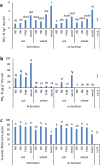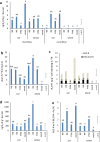Edaphic factors and plants influence denitrification in soils from a long-term arable experiment
- PMID: 32994429
- PMCID: PMC7524710
- DOI: 10.1038/s41598-020-72679-z
Edaphic factors and plants influence denitrification in soils from a long-term arable experiment
Abstract
Factors influencing production of greenhouse gases nitrous oxide (N2O) and nitrogen (N2) in arable soils include high nitrate, moisture and plants; we investigate how differences in the soil microbiome due to antecedent soil treatment additionally influence denitrification. Microbial communities, denitrification gene abundance and gas production in soils from tilled arable plots with contrasting fertilizer inputs (no N, mineral N, FYM) and regenerated woodland in the long-term Broadbalk field experiment were investigated. Soil was transferred to pots, kept bare or planted with wheat and after 6 weeks, transferred to sealed chambers with or without K15NO3 fertilizer for 4 days; N2O and N2 were measured daily. Concentrations of N2O were higher when fertilizer was added, lower in the presence of plants, whilst N2 increased over time and with plants. Prior soil treatment but not exposure to N-fertiliser or plants during the experiment influenced denitrification gene (nirK, nirS, nosZI, nosZII) relative abundance. Under our experimental conditions, denitrification generated mostly N2; N2O was around 2% of total gaseous N2 + N2O. Prior long-term soil management influenced the soil microbiome and abundance of denitrification genes. The production of N2O was driven by nitrate availability and N2 generation increased in the presence of plants.
Conflict of interest statement
The authors declare no competing interests.
Figures




Similar articles
-
Organic fertilization reduces nitrous oxide emission by altering nitrogen cycling microbial guilds favouring complete denitrification at soil aggregate scale.Sci Total Environ. 2024 Oct 10;946:174178. doi: 10.1016/j.scitotenv.2024.174178. Epub 2024 Jun 23. Sci Total Environ. 2024. PMID: 38917905
-
nirS and nosZII bacterial denitrifiers as well as fungal denitrifiers are coupled with N2O emissions in long-term fertilized soils.Sci Total Environ. 2023 Nov 1;897:165426. doi: 10.1016/j.scitotenv.2023.165426. Epub 2023 Jul 8. Sci Total Environ. 2023. PMID: 37429471
-
Diversified crop rotations exert a profound influence on the nosZI denitrifier community.Sci Total Environ. 2025 Jan 1;958:177871. doi: 10.1016/j.scitotenv.2024.177871. Epub 2024 Dec 13. Sci Total Environ. 2025. PMID: 39674165
-
[Key microbial processes in nitrous oxide emissions of agricultural soil and mitigation strategies].Huan Jing Ke Xue. 2014 Feb;35(2):792-800. Huan Jing Ke Xue. 2014. PMID: 24812980 Review. Chinese.
-
Soil microorganisms as controllers of atmospheric trace gases (H2, CO, CH4, OCS, N2O, and NO).Microbiol Rev. 1996 Dec;60(4):609-40. doi: 10.1128/mr.60.4.609-640.1996. Microbiol Rev. 1996. PMID: 8987358 Free PMC article. Review.
References
-
- Smith KA. Changing views of nitrous oxide emissions from agricultural soil: Key controlling processes and assessment at different spatial scales. Eur. J. Soil Sci. 2017;68:137–155. doi: 10.1111/ejss.12409. - DOI
-
- Philippot L, Hallin S, Schloter M. Ecology of denitrifying prokaryotes in agricultural soil. Adv. Agron. 2007;96(96):249–305. doi: 10.1016/S0065-2113(07)96003-4. - DOI
-
- Bouwman AF. Direct emission of nitrous oxide from agricultural soils. Nutr. Cycl. Agroecosyst. 1996;46:53–70. doi: 10.1007/Bf00210224. - DOI
Publication types
MeSH terms
Substances
Grants and funding
- BB/E/C/0005196/BB_/Biotechnology and Biological Sciences Research Council/United Kingdom
- BB/NO13468/1/BB_/Biotechnology and Biological Sciences Research Council/United Kingdom
- BBS/E/C/000I0310/BB_/Biotechnology and Biological Sciences Research Council/United Kingdom
- BBS/E/C/000J0300/BB_/Biotechnology and Biological Sciences Research Council/United Kingdom
LinkOut - more resources
Full Text Sources

